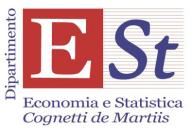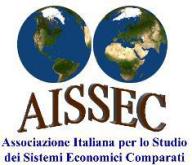by Elisabetta Gentile[*] and Gaaitzen J. de Vries[†]
In 2019, Asia’s global value chain (GVC) participation—defined as the share of gross exports of value added used for further processing through cross-border production networks—was 67.4%, making it a key global player. Yet, income per capita in developing Asian economies is still about one third of the level in OECD countries. Why is income per capita convergence incomplete? We investigate this question by measuring jobs and income in the GVCs of final manufactured products. We combine new data on occupational tasks with multi-regional input-output tables to examine fifteen developing Asian economies from 2000 to 2018. The accounting framework conveys diversity in what drives convergence. Various economies, such as Bangladesh, Cambodia, Viet Nam and the PRC, achieved a rapid expansion in the scale of production activities within GVCs. Several economies, including the PRC, Thailand, and Viet Nam, increased productivity in knowledge-intensive activities, suggesting full income convergence is underway.
Participation in global value chains (GVCs) is widely viewed as a powerful driver of growth, productivity, and job creation. The ‘East Asian miracle’—which saw the region grow faster than any other during the second half of the 20th century—is presented as evidence of this link (Gereffi 1999). However, with the 21st century came the concern that, while developing Asia has been successful in increasing employment in labor-intensive production activities and emulating production techniques, the switch from imitation to innovation is more difficult yet necessary to avoid a middle-income trap (Bulman, Eden, and Nguyen 2017).
We use a task-based GVC accounting approach to examine how the scale of participation, the productivity level of the activities performed, and the types of activities carried out along the value chain drive income convergence. Our findings aim to shed light on why, as of 2018, GDP per capita in developing Asian economies is about one third the level in Organisation for Economic Co-operation and Development (OECD) member countries.
The focus of our study is not manufacturing industries in developing Asia, but rather the set of activities carried out in the region for final manufactured products produced anywhere in the world. For example, an Asian firm might be involved in business processing, such as data entry, accounting, or call centers, for a final manufacturing product from a firm in France. This is the concept of “manufactures GVC income” or simply GVC income, introduced by Timmer et al. (2013). Indeed, activities in GVCs of manufactured products can be performed by firms classified in any sector of the economy. That is why the use of input-output linkages is required to explicitly account for interdependence among firms.
Similarly, GVC jobs are defined as jobs related to activities that are directly and indirectly involved in the production of final manufactured goods. This is not the classic definition of manufacturing jobs, because it includes jobs in non-manufacturing activities if they contribute to final manufacturing output.
In a value chain, pre- production activities are carried out by workers with occupations relating to R&D and design; production activities are the tasks carried out by workers with occupations involved in the physical transformation process; and post- production activities are carried out by workers with occupations relating to branding, marketing, and logistics. To keep the analysis manageable, we merge pre- and post- production activities into one category that we call knowledge-intensive activities. That is because both pre- and post- production activities have higher value added than production activities and require higher-skilled workers.
Based on the framework introduced by Buckley et al. (2020), an economy can increase GVC income through three main drivers. The first is an increase in the scale of activities carried out for GVCs of final manufactured products (i.e., the number of jobs involved in those activities). The second is increasing the productivity levels of those activities through either process upgrading (better organization of the production process or using improved technology) or product upgrading (improving quality or design or adding new features). The third is functional upgrading; this is the reallocation of jobs from low to high value-added activities within GVCs. The highest value creation generally occurs in more upstream processes (e.g., R&D and design) or more downstream processes (e.g., marketing) rather than in the middle (e.g., assembly) (Shih 1996). Most of this value added stems from intangibles, such as brands, basic R&D, design, and the digitalization of organizational processes.
Two datasets underpin this quantitative exercise. First, the Multiregional Input–Output (MRIO) Database of the Asian Development Bank, which comprises national input-output tables connected by means of bilateral international trade flows. Each table provides a comprehensive summary of all transactions in the global economy between industries and final users of goods and services across countries in a given year. Second, the Occupations Database, introduced in Reijnders and de Vries (2018), which provides information on employment and relative wages by occupation-country-sector-year. The original occupations database includes 40 economies, including the People’s Republic of China, India, Indonesia, and Taipei,China. For the analysis in this article, an additional 11 developing Asian economies[1] have been added to the set. Finally, the data was broken down by workers involved in production activities, i.e., the physical transformation process of manufactured goods, and knowledge-intensive activities, i.e., pre- and post-production tasks.
Figure 1 shows that GVC income per capita can be disaggregated at two levels. In the first, GVC income per capita is expressed as the product of scale (GVC jobs per capita) and productivity (GVC income per GVC job). An increase in scale means that a rising share of the population is involved in GVCs; an increase in GVC income per GVC jobs means that workers performing those jobs are getting more productive.
Figure 1: Disaggregating GVC Income per Capita
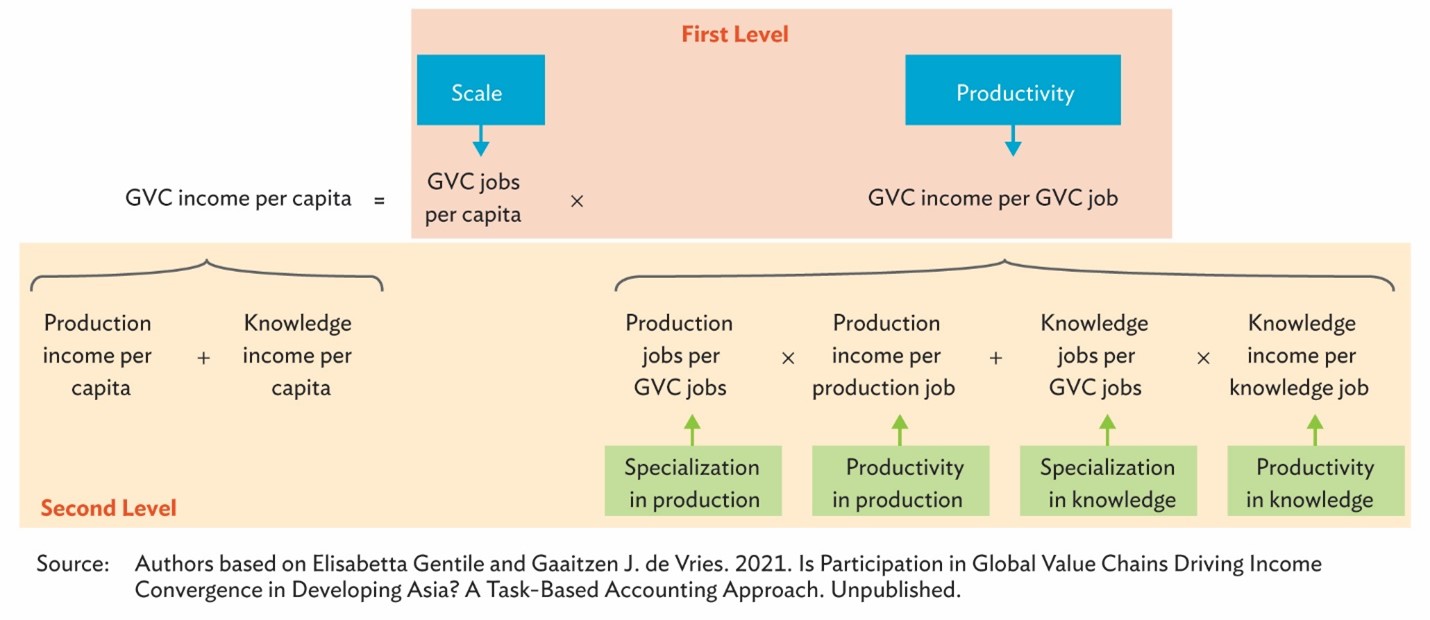
Figure 2 shows the results of the first-level disaggregation, where scale and productivity are divided by the OECD average. Panel a shows that in 2000, nine out of the 15 developing Asian economies had a scale ratio above 1, implying they had more GVC jobs per capita than the OECD average. That increased to 12 in 2018—and the ratio for India, Indonesia, the PRC, Taipei,China, and Thailand was above 2, which highlights the active involvement of workers from Asia in manufacturing GVCs. The scale ratio for the aggregate of the 15 economies was 1.34 in 2000 and 2.10 in 2018. This suggests the GVC income gap between developing Asia and the OECD is not due to the overall scale of their involvement in GVCs. Panel b shows the gap in GVC income between developing Asia and the OECD is mainly accounted for by differences in productivity. In 2000, developing Asia’s productivity ratio was about 9% of the OECD’s average. Although productivity has increased rapidly since then, it started from a low level, such that it was still at only 16% of the OECD average in 2018.
Figure 2: Scale Ratio and Productivity Ratio in 15 Developing Asian Economies, 2000 and 2018
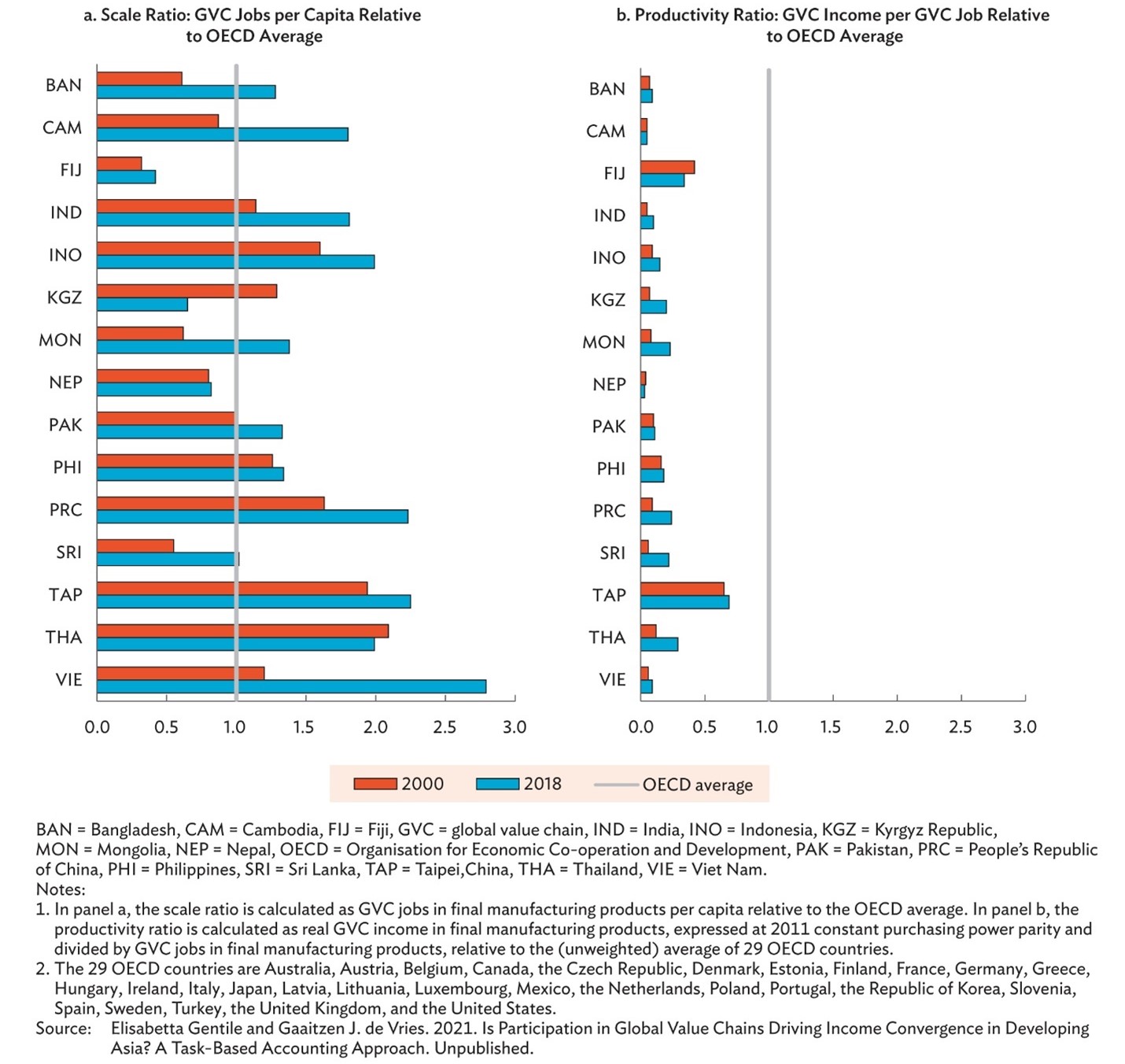
The second level of the disaggregation shown in Figure 1 sheds light on functional upgrading. Productivity is disaggregated into the weighted sum of production income per production job (productivity in production) and knowledge income per knowledge job (productivity in knowledge). The weights are the share of production jobs to total GVC jobs (specialization in production) and the share of knowledge jobs to total GVC jobs (specialization in knowledge). An increase in the share of knowledge jobs to total GVC jobs is an indication that the economy is specializing in knowledge-intensive activities. Similarly, an increase in the share of production jobs to total GVC jobs would be an indication that the economy is specializing in production activities.
Figure 3 presents the results of the second-level disaggregation of the productivity ratio shown in Figure 1 into the specialization-in-production ratio, the productivity in production ratio, the specialization-in-knowledge ratio, and the productivity in knowledge ratio. Panel a clearly shows that GVC income convergence was mainly driven by an expansion of GVC jobs in production, whereas the share of knowledge-intensive jobs is roughly 50% of the OECD average, with the exception of Fiji and Taipei, China. These reflect a global division of labor whereby more knowledge-intensive jobs are in advanced economies and more production jobs are in developing Asia. Yet knowledge-intensive jobs increased in developing Asia from 2000 to 2018. Panels c and d show that most developing Asian economies in the sample increased productivity in both production and knowledge-intensive activities from 2000 to 2018.
In sum, while exporting through GVCs is often seen as a panacea for weak industrialization trends in developing economies, the reality is more complex. Even in developing Asia, which has seen a massive increase in the scale of production activities, productivity convergence and functional upgrading have been slow and far from guaranteed, as shown by the diversity of outcomes across the 15 economies examined here. However, we also show the importance of upscaling in driving income convergence and that the volume of the activity matters just as much as the domestic share of the value of the product in driving income convergence.
Figure 3: Specialization and Productivity Ratios by Activity in 15 Developing Asian Economies, 2000 and 2018
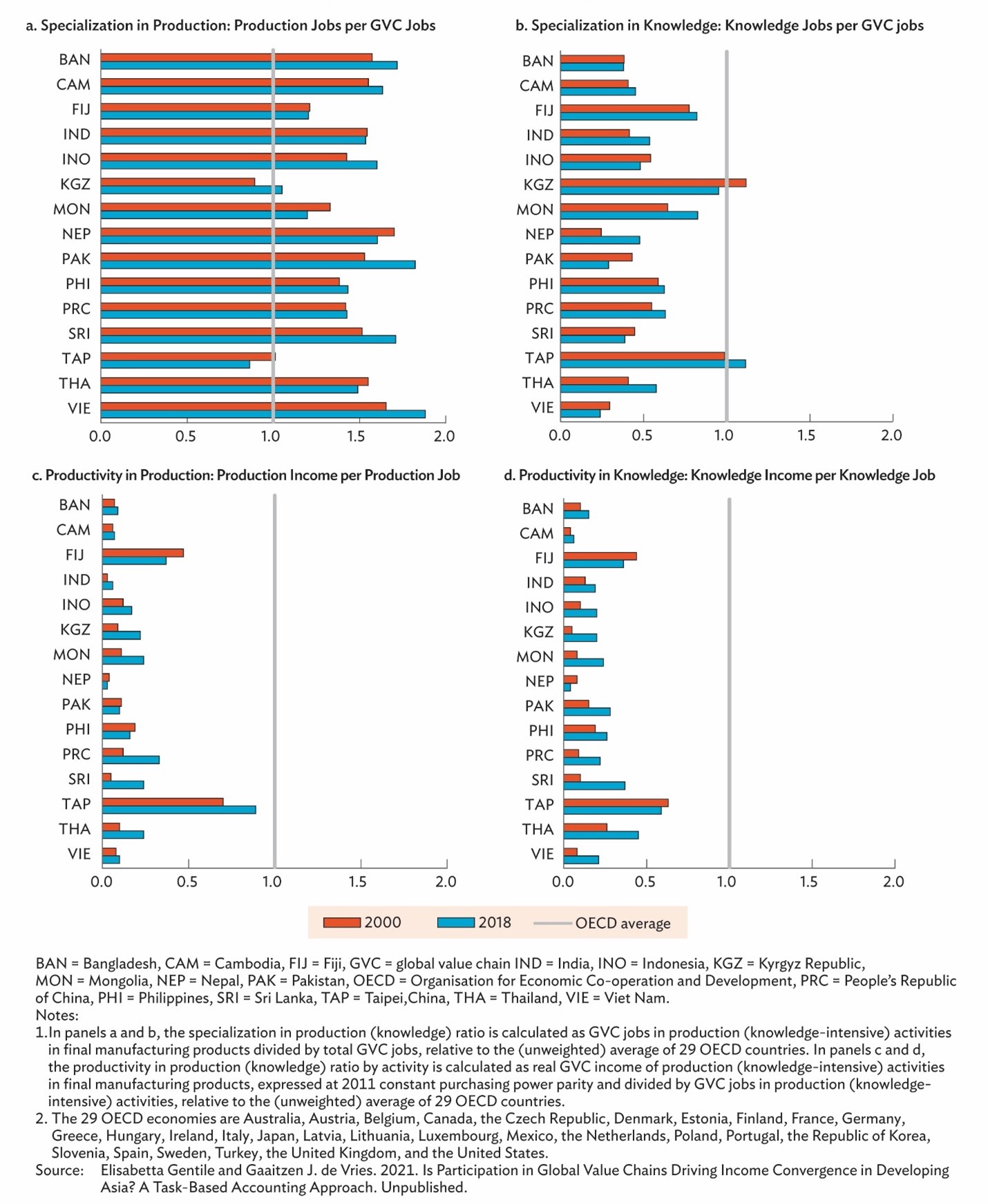
References
Buckley, Peter J. and Roger Strange and Marcel P. Timmer and Gaaitzen J. de Vries. 2020. “Catching up in the Global Factory: Analysis and Policy Implications” Journal of International Business Policy 3:79-106.
Bulman, David and Maya Eden and Ha Nguyen. 2017. “Transitioning from low-income growth to high-income growth: is there a middle-income trap?” Journal of the Asia Pacific Economy 22:1, 5-28.
Gentile, Elisabetta and Gaaitzen J. de Vries. 2021. “Is Participation in Global Value Chains Driving Income Convergence in Developing Asia? A Task-Based Accounting Approach.” Working paper.
Gereffi, Gary. 1999. “International Trade and Industrial Upgrading in the Apparel Commodity Chain.” Journal of international economics 48(1): 37-70.
Reijnders, Laurie S. and Gaaitzen J. de Vries. 2018. “Technology, Offshoring and the Rise of Non-Routine Jobs.” Journal of Development Economics 135: 412-432.
Timmer, Marcel P. and Bart Los and Robert Stehrer and Gaaitzen J. de Vries. 2013. “Fragmentation, Incomes, and Jobs: An Analysis of European Competitiveness.” Economic Policy 28(76): 613-661.
[*] South Asia Department, Asian Development Bank; Email:
[†] Faculty of Economics and Business, University of Groningen; Email:
[1] Bangladesh, Cambodia, Fiji, Kyrgyz Republic, Mongolia, Nepal, Pakistan, the Philippines, Sri Lanka, Thailand, and Viet Nam.







